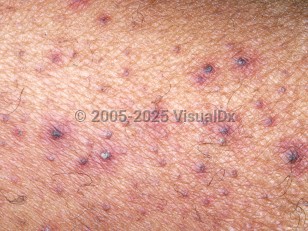Scurvy in Child
See also in: Oral Mucosal LesionAlerts and Notices
Important News & Links
Synopsis

Scurvy is an acquired condition caused by a deficiency of vitamin C (L-ascorbic acid). Humans are unable to synthesize vitamin C; hence, it must be consumed in the diet. Deficiency of this essential nutrient causes impaired collagen synthesis, which leads to poor wound healing, capillary fragility, and bone abnormalities (eg, osteoporosis, fractures, bone marrow edema, demineralization, intraosseous hemorrhage). In developed countries, scurvy is a relatively rare diagnosis primarily found in older adults, those who abuse alcohol, and infants and children.
Scurvy can present with wide clinical variation, including dermatologic, dental, bone, and systemic manifestations. Clinical features of scurvy may be observed within 8 weeks of inadequate intake of vitamin C. The initial symptoms include irritability, decreased appetite, and low-grade fever. Dermatologic signs include xerosis, hyperkeratosis, perifollicular hemorrhage, scattered petechiae and ecchymoses, and corkscrew hairs. Oral findings include swollen, friable gingiva. In children, scurvy can present with joint swelling and refusal to walk, and bone growth may be inhibited. Rare presentations of scurvy include proptosis due to orbital hemorrhage, skeletal muscle degeneration, cardiac hypertrophy, psychological changes, edema, and alopecia. Untreated, scurvy can be fatal; deaths have been reported due to infection, cerebral hemorrhage, or hemopericardium. Up to 80% of patients with scurvy present with (mostly mild) anemia.
In pediatric populations, at-risk individuals include those with iron overload, neurologic disorders, a history of bone marrow transplant, and/or chemotherapy. Additionally, children with restricted diets, especially in the setting of autism or developmental delay, are at increased risk.
Scurvy can present with wide clinical variation, including dermatologic, dental, bone, and systemic manifestations. Clinical features of scurvy may be observed within 8 weeks of inadequate intake of vitamin C. The initial symptoms include irritability, decreased appetite, and low-grade fever. Dermatologic signs include xerosis, hyperkeratosis, perifollicular hemorrhage, scattered petechiae and ecchymoses, and corkscrew hairs. Oral findings include swollen, friable gingiva. In children, scurvy can present with joint swelling and refusal to walk, and bone growth may be inhibited. Rare presentations of scurvy include proptosis due to orbital hemorrhage, skeletal muscle degeneration, cardiac hypertrophy, psychological changes, edema, and alopecia. Untreated, scurvy can be fatal; deaths have been reported due to infection, cerebral hemorrhage, or hemopericardium. Up to 80% of patients with scurvy present with (mostly mild) anemia.
In pediatric populations, at-risk individuals include those with iron overload, neurologic disorders, a history of bone marrow transplant, and/or chemotherapy. Additionally, children with restricted diets, especially in the setting of autism or developmental delay, are at increased risk.
Codes
ICD10CM:
E54 – Ascorbic acid deficiency
SNOMEDCT:
76169001 – Scurvy
E54 – Ascorbic acid deficiency
SNOMEDCT:
76169001 – Scurvy
Look For
Subscription Required
Diagnostic Pearls
Subscription Required
Differential Diagnosis & Pitfalls

To perform a comparison, select diagnoses from the classic differential
Subscription Required
Best Tests
Subscription Required
Management Pearls
Subscription Required
Therapy
Subscription Required
References
Subscription Required
Last Reviewed:10/03/2017
Last Updated:09/15/2025
Last Updated:09/15/2025
Scurvy in Child
See also in: Oral Mucosal Lesion
